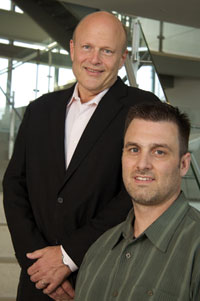Indiana University
For the hundreds of IT staff across Indiana University's departments and campuses, virtualized on-demand software delivery is the model of the future. "An enterprise approach to desktop management--combined with tools to virtualize application delivery--can significantly advance innovation and operational effectiveness throughout the IU information technology community," observes Duane Schau, the school's director of leveraged support. "This is the way software will be delivered in the future."

Indiana University project team members Duane Schau (left) and Pete Bucklin |
Dubbed "IUanyWARE," the initiative provides students, faculty, and staff with free, anytime, anywhere access to hundreds of software resources. Launched in March 2011, the project delivered applications to more than 97,000 students and 16,000-plus faculty and staff at eight campuses across the state during the fall 2011 semester.
The solution incorporates several vendor products, but is based heavily on Citrix technologies. The key Citrix product is XenApp, a central hosting and application server that presents applications to almost any device, including those operating on PC, Mac, iOS, and Android platforms. All available applications are stored on a Microsoft App-V hub on Dell servers; App-V streams the applications to the XenApp server.
IU has purchased enterprise licenses for an impressive array of more than 200 apps--including Adobe Creative Suite, Microsoft Office, IBM SPSS, and SAS OnDemand--allowing the university to provide them free to the IU community. For storage, application users can choose between public cloud-based systems or a Microsoft SharePoint storage allocation from IU's ambitious private cloud, a data-storage project that uses Hitachi server products.
Schau points to a weakness in traditional higher education IT operations that caused IU to explore virtualized application delivery. "Most universities still have a mid-1990s model that evolved from a very decentralized approach to managing personal computers," he explains. "That made sense years ago when we had to be experts at everything about PCs--from ordering, to setup and maintenance, through the whole lifecycle." At IU, nearly 100 separate IT shops emerged to handle this for their departments.
"As the technology changed over time," adds Schau, "we realized we were working too hard at this and wasting resources."
Sue Workman, associate VP of client services and support, agrees. "Indiana University is taking a very important step in transforming desktops and applications into a leveraged, on-demand personal cloud service," she explains. "This project is part of a major initiative to rethink the way we are delivering IT services to all of the university community, and to be able to reduce desktop support needs and deploy those resources to more strategic initiatives." The streamlined approach has freed technology staff to focus on more productive and innovative duties in support of research and teaching.
IU's students, faculty, and staff are thrilled with the ability to access extensive computing resources in a virtual instant. "Just give me a device--any device that can access the web and has a browser--and I can get to any applications I need," says Pete Bucklin, director of facilities and IT infrastructure at the School of Informatics and Computing. "I can get to my mail, and my file storage…I can get to work instantly and be productive."
About the Author
Meg Lloyd is a Northern California-based freelance writer.